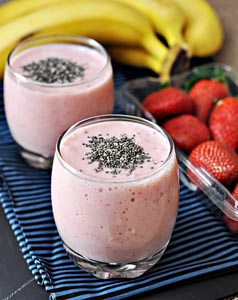
Having written a bit about chia some years back, as part of an article on the use of seeds in Mexican cooking, I was not surprised to learn that chia seeds have been lauded as the new superfood of 2013.
Nutritionally dense, chia seeds are loaded with antioxidents, fiber, protein, and omega-3 fatty acids. They are also gluten free and have anti-inflammatory properties. The ancient people of Mexico, including the Aztecs and Maya, were onto something long before the 1980s, when clay “chia pets” became popular. We should have realized, when the moistened seeds sprouted almost overnight, that there was a great deal of vitality in them. All seeds contain energy needed by young plants to develop, and chia is exceptionally fast to germinate.
Chia seeds met the nutritional needs of early Mesoamericans, and were so valued by the Aztecs that they were considered one of the four grains acceptable as tribute to the Aztec state. Salvia hispanica (the plant’s botanical name) was used to prepare a nourishing gruel, and was served as a beverage to women while chocolate was served to the men at the emperor Moctezuma’s court. This was probably the thick drink called chianatolli, made with toasted, ground chia seeds.
Nowadays the most common chia beverage is agua de chia, a refreshing drink made with lime juice and sweetened with sugar. It is especially popular during Mexico’s hot spring season, when refreshment booths set up for Semana Santa sell many gallons of chia water. This is probably due to the seeds’ ability to absorb and hold liquids, thereby helping to prevent dehydration.
It is used this way by the Tarahumara, called the “running people,” who live in the canyons of Northwest Mexico’s Sierra Madre Occidental. Often living long distances apart, their dwellings are connected by narrow mountain footpaths, and walking and running are their chief modes of transportation. Besides preventing the runners from becoming dehydrated, chia seeds help to ward off hunger, since they form a filling gel as they absorb water. (For this reason, chia seeds, which help give a feeling of fullness, have been touted as a weight loss aid in recent years.)
Two tablespoons of chia seeds have the same amount of protein as one egg, and one tablespoon of chia seeds has the same amount of omega-3 contained in a four ounce serving of salmon. With 64 milligrams of calcium, 40 milligrams of magnesium, and only 60 calories in the same tablespoonful, chia is a nutritional powerhouse. There is no nutritional difference between black and white chia seeds. Some people prefer white, since it “blends in” with other foods, though I personally love the contrast of black chia seeds, which look as cheery as a sprinkling of poppy seeds.
The seeds are easy to use, essentially flavorless, and can be sprinkled on anything from hot or cold cereal to salad. Stir them into soups or stews, where they make a nutritious, fiber-filled thickener. Use them in smoothies, add them to yogurt with fruit, or to muffins or cookies. The seeds do not have to be ground to access important nutrients, except when used in baking as a substitute for eggs, a great boon for vegans. Grind one tablespoon of chia seeds in a spice grinder and mix with a quarter cup of cold water to take the place of one egg.
Chia seeds are found in most markets in Mexico, in the stalls where dried chiles and spices are sold. Do not heed the Internet “warnings” that only South American chia seeds are beneficial. They are indigenous to Mexico and Guatemala, and I have bought them in Mexican mercados for years. North of the border, they can be purchased in health food stores and in some supermarkets, especially now that they have been “discovered” as a superfood.
If your New Year’s resolutions involve any health or diet related issues, or if you just want to add a significant nutritional boost to your meals, add chia seeds to just about anything or try one of the following recipes.
- Mexican chia seed drink: Agua de chia
- Mexican lentil vegetable soup with chia: Sopa de lentejas y verduras con chia
- Mexican fish cakes with chile and chia: Tortitas de pescado con chile y chia
- Mexican chia fruit gelatin: Gelatina de frutas con chia
- Mexican chia coconut pudding: Postre de chia y coco

